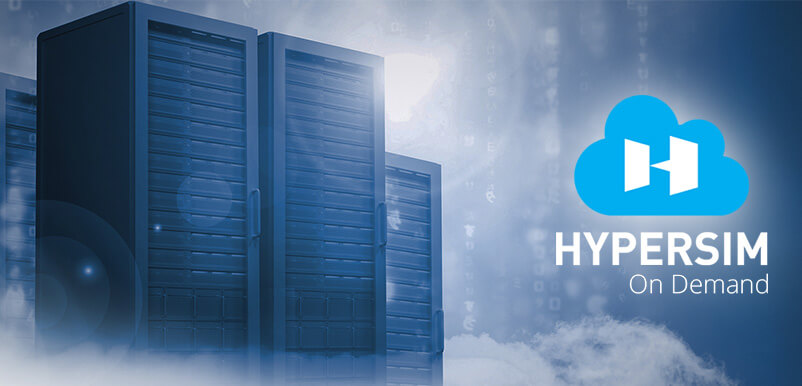Product News
November 12, 2018
HYPERSIM on Demand

As part of an ongoing blog post series reflecting on our biggest product introductions of 2018, we spoke with HYPERSIM Product Manager, Etienne Leduc. Etienne comments here on the introduction of OPAL-RT’s new EMT prep station platform offering, HYPERSIM on Demand. It allows users to accelerate the prototyping, development and testing of power system equipment on remote servers, without concerns about IT resources, licensing, or scarcity of performant hardware availability.
What is perhaps the most innovative feature though, is that since the cloud is infinitely scalable, and since HYPERSIM on Demand works on a ‘# of cores times # of hours’ pricing model, scenarios the industry has never been able to accommodate suddenly become available, and former limitations are struck down. A train manufacturer with a new network design, for example, may require 20,000 hours of simulation to satisfy industry requirements. The math on this is simple: 20 cores times 1,000 hours each—or, for that matter, 200 cores times 100 hours each: the choice is yours!
We spoke with Etienne as he prepared for the company’s participation at CIGRE, a world forum for power systems important to several of OPAL-RT’s core sectors.
Interviewer [IV]: “So, Etienne. Good day. You’re the HYPERSIM product manager and have been for a while. How do you see this suite of tools as an addition to the simulation capabilities at any given ‘shop’?“
Etienne Leduc [EL]: “Good day to you! Well, first of all, make no mistake, it’s currently possible to run real-time simulations only on our HIL simulators to test external devices such as PMUs and controllers. In that way, the cloud implementation is not meant to be everything to all people; but what it does open up and make abundantly possible is very exciting in and of itself.”
“We were already very proud of the speed at which the user can prepare their real-time simulation and run offline tests on their own Windows PC, thanks to our know-how in parallelizing computation. This is called ‘accelerated simulation’ or ‘faster than real-time’. This particular capability is not currently available on the power system simulation market elsewhere, and with cloud simulation, we’ve pushed it multiple levels further—it’s truly amazing!”
“Another thing we’re currently investigating is to make sure that the latency between the data centers and the hardware in the user’s lab is low enough to run tests using Ethernet-based communication protocols, such as C37.118, OPC-UA or other SCADA protocols. The remote cloud server solutions are coming of age, and are filling in niche needs, use cases, and scenarios that have always existed, but perhaps have not been addressed directly up to this point due to various limitations.”
“So we’ve already changed the market thanks to the ‘very high performance at very low cost’ that our cloud services represent, and we’ll continue to change it further once we’ve enabled cloud-based Hardware-in-the-Loop simulation.”
IV: “We’re the first company in our market to make it to the ‘cloud’—how do you feel about us being ‘disruptive’ in this way, and how might it help or change the market?”
EL: “You know, OPAL-RT has always been about disruptive innovation and democratizing real-time simulation. We’ve had a dream since 1997, and a credo that goes with it, to “put a high-end simulator on every engineer’s desk”. Jean Bélanger and Lise Laforce, our founders, were and are very serious about this. To achieve this dream, we have to work on multiple aspects of our products, such as performance, usability, reliability, ease of access, etc.”
“And cloud services address exactly these aspects. By having your simulation computationally powered by Amazon, you ensure data security, you have access to the latest hardware technology, and can simulate from anywhere around the globe, as long as you have an internet connection. More and more tools—powerful, world-class tools—are available nowadays directly through a web browser, or through the Software as a Service [SaaS] business model, and this is also a next step we are aiming at; we have some milestones attached to that. One of the ways this becomes really exciting for our core customers in various key sectors is that the user is entirely freed from managing software versions, subsystems, licensing, and hardware, and whose turn it is to use the IT resources that week, etc. All that just becomes a non-issue at this stage.”
IV: “How might existing OPAL-RT customers or new ones work this into their simulation routines, depending on the simulation type they’re doing?”
EL: “The answer to this is so simple that it’s also disruptive! From the software point of view, the user simply has to add the virtual simulator, as with any other target, by using HYPERSIM’s target manager and inputting the IP address. From the point of view of habitual workflow, all users have to validate various elements of their model(s), at various stages, and prepare test cases before they go to real-time.”
“If the access to the simulator is limited, whether it’s shared with colleagues or located in another building, for example, the user could previously only run their simulations on their own machines. And this is what everyone got used to doing! Now: this might work seamlessly for smaller models, but if you’ve got complex or much larger models, you’d be rapidly pretty limited as you sat and watched your machine chew on the simulation. And an extremely powerful personal computer (which may only be required for a small portion of the time) is not necessarily within the reach of every user, or university budget, or design lab.”
“So as soon as the user feels their simulation is running too slowly–which is common these days with the integration of distributed generation, more complex control and protection schemes, FACTS and HVDC, etc.–they can switch, in literally one click, to a virtual, fast parallel simulator, and access the massive server power of Amazon. And the power is far from being the only great thing about it. When validating a model, you can spend a lot of time analyzing data after the simulation itself—going back and looking at various items forensically. With the service we’re offering, the user pays only for the time during which they actually use the virtual simulator—not for the time it’s sitting around unused during data analysis, for example.”
“There are various ideal use cases for HYPERSIM on Demand, and what they all have in common is high need for short-term computational power and immediate access to resources: students with huge end-of-term Engineering projects and theses; or manufacturers who have to do what used to be cripplingly large chunks of simulation in a short time. This is a solution whose time has come, and we’re receiving a lot of enthusiastic feedback from various sectors.”
IV: “Why would a client use HYPERSIM on Demand if they already had a fast real-time simulator—either HYPERSIM or another competitive solution?”
EL: “It’s a matter of asset optimization. In practice, several simulation specialists need to perform offline simulation studies during several months using software like PSCAD and EMTP-RV before performing real-time simulation tests for hardware-in-the-loop (HIL) with an external control replica. These specialists must optimize the global power grid, including protection and control systems using approximate numerical models. Several teams must work concurrently to find the critical cases to be simulated later, using actual protection and control system replicas.”
“In theory, the real-time simulator could be used to perform offline studies faster, since they use parallel processing. But in practice, real-time simulators are a precious asset always used to test actual protection and control hardware systems. As a result, using HYPERSIM on Demand offers the possibility of executing several simulation studies concurrently by several teams while the real-time simulator is busy. This is called ‘Software-in-the-loop’, implying that control and protection systems are simulated in software instead of using the actual hardware.”
IV: “What are the real advantages of HYPERSIM on Demand over more classical methods consisting of running several single-processor simulations in parallel?”
EL: “It is true that running 100 simulations taking ten minutes each will give 100 results after 10 minutes if 100 processors are used to simulate a moderately large network. On the other hand, HYPERSIM will give one result every six seconds due to its very efficient parallel computing features—whose efficiency increases with the complexity and size of the power grid. This means two things. One, that users are getting much better interactivity! This is like HIL, but with a Human-in-the-Loop! If the simulation goes poorly for any reason, you don’t have to wait 10 minutes before you realize it. This means users can interact with the simulation to find worst-case scenarios using human intelligence and intuition. And two, this also means that one could develop an automatic testing system based on clever algorithms or artificial intelligence to find the worst cases and to optimize parameters automatically and in less time. It’s all about making more sophisticated tests in less time, in order to decrease time-to-commissioning, even with increasing grid size and complexity.”
IV: “Etienne, I’d like to thank you for your time, and for this glimpse into the potential future of simulation. Very informative and entertaining—thanks.”
—
Etienne Leduc | Product Owner of HYPERSIM®
 Etienne Leduc received his bachelor’s degree in Electrical Engineering from Germany’s Bremen University of Applied Sciences in 2013 and joined the R&D department of OPAL-RT upon his return to Canada. After having worked in the protection field and IEC 61850 with HYPERSIM for a year, Etienne focused on providing services for the growing number of HYPERSIM customers. Etienne was promoted to Product Owner of HYPERSIM in 2015, and has since been dedicated to planning and designing the software suite’s evolution and development.
Etienne Leduc received his bachelor’s degree in Electrical Engineering from Germany’s Bremen University of Applied Sciences in 2013 and joined the R&D department of OPAL-RT upon his return to Canada. After having worked in the protection field and IEC 61850 with HYPERSIM for a year, Etienne focused on providing services for the growing number of HYPERSIM customers. Etienne was promoted to Product Owner of HYPERSIM in 2015, and has since been dedicated to planning and designing the software suite’s evolution and development.For more on HYPERSIM on Demand: https://www.opal-rt.com/hypersimondemand/















